Laser Alloying Monel 400 with Amorphous Boron to Obtain Hard Coatings
Abstract
1. Introduction
2. Material and Methods
2.1. Material
2.2. Laser Heat Treatment Process
- Et—interaction time of laser beam on material [s],
- dl—laser beam diameter [mm],
- vl—scanning speed [mm/s].
- F—laser beam fluence [J/mm2],
- P—laser beam power [W],
- r—radius of the laser beam [mm],
- Et—interaction time of laser beam on material [s].
2.3. Specimens Preparation
2.4. Specimens Examination
3. Results and Discussion
3.1. Surface Visual Investigation
3.2. Microstructure and Depth of Remelting
3.3. Microhardness
4. Conclusions
- (1)
- Remelting Monel 400 with diode laser leads to obtaining a dendritic structure, in which the size of dendrites lowers with increasing laser beam scanning velocity and their orientation is perpendicular to the surface on the top of specimens. Inside laser tracks orientation of dendrites is variable and depends on substrate structure and local thermal gradients in the molten pool. The addition of boron to the molten pool results in modification of dendrites’ orientation and the more borides in remelted area, the less noticeable dendrites are.
- (2)
- The depth of remelting depends not only on the laser beam scanning velocity but also on the initial content of boron. The low concentration of borides in the molten pool decreases the total thermal conductivity of the Monel 400-boron system. However, high enough amount of boron in the molten pool increases its thermal conductivity resulting in obtaining deeper laser tracks. Depth of re-melted zone decreased from 360 μm to 310 μm due to addition of initial boron layer 100 μm thick and increased to 420 μm when the thickness of initial layer was doubled.
- (3)
- Microhardness of Monel 400 does not change after remelting it using diode laser, regardless of the laser beam scanning velocity. The addition of the initial boron layer results in increasing the microhardness and the higher boron content and the laser beam scanning velocity, the harder produced surface layer is. Thus, the highest, six-times increase in microhardness (from 160 HV0.1 to 980 HV0.1) was observed in laser track produced with initial boron layer 200 μm thick using laser beam scanning velocity equal to 75 m/min.
Author Contributions
Funding
Conflicts of Interest
References
- Padmanabham, G.; Bathe, R. Laser Materials Processing for Industrial Applications. Proc. Natl. Acad. Sci. India Sect. A Phys. Sci. 2018, 88, 359–374. [Google Scholar] [CrossRef]
- Wang, Z.; Zhang, Q.; Guo, P.; Gao, X.; Yang, L.; Song, Z. Effects of laser surface remelting on microstructure and properties of biodegradable Zn-Zr alloy. Mater. Lett. 2018, 226, 52–54. [Google Scholar] [CrossRef]
- Campanelli, S.I.; Angelastro, A.; Posa, P.; Daurelio, G. Fiber laser surface remelting of a nickel-based superalloy by an integrated rectangular laser spot. Opt. Laser. Eng. 2018, 111, 42–49. [Google Scholar] [CrossRef]
- Zang, C.; Zhou, T.; Zhou, H.; Yuan, Y.; Zhang, P.; Meng, C.; Zhang, Z. Effects of substrate microstructure on biomimetic unit properties and wear resistance of H13 steel processed by laser remelting. Opt. Laser Technol. 2018, 106, 299–310. [Google Scholar] [CrossRef]
- Zhao, X.; Zhang, H.; Liu, Y. Effect of laser surface remelting on the fatigue crack propagation rate of 40Cr steel. Results Phys. 2019, 12, 424–431. [Google Scholar] [CrossRef]
- Yu, J.; Wang, Y.; Zhou, F.; Wang, L.; Pan, Z. Laser remelting of plasma-sprayed nanostructured Al2O3-20 wt.% ZrO2 coatings onto 316L stainless steel. Appl. Surf. Sci. 2018, 431, 112–121. [Google Scholar] [CrossRef]
- Cai, Z.; Cui, X.; Liu, Z.; Li, Y.; Dong, M.; Jin, G. Microstructure and wear resistance of laser cladded Ni-Cr-Co-Ti-V high- entropy alloy coating after laser remelting processing. Opt. Laser Technol. 2018, 99, 276–281. [Google Scholar] [CrossRef]
- Bonek, M. The investigation of properties of high-speed steel after laser surface treatment. Arch. Metall. Mater. 2018, 63, 227–233. [Google Scholar]
- Li, Z.; Wei, M.; Xiao, K.; Bai, Z.; Xue, W.; Dong, C.; Wei, D.; Li, X. Microhardness and wear resistance of Al2O3-TiB2-TiC ceramic coatings on carbon steel fabricated by laser cladding. Ceram. Int. 2019, 45, 115–121. [Google Scholar] [CrossRef]
- Gao, W.; Chang, C.; Li, G.; Xue, Y.; Wang, J.; Zhang, Z.; Lin, X. Study on the laser cladding of FeCrNi coating. Optik 2019, 178, 950–957. [Google Scholar] [CrossRef]
- Nikitin, A.A.; Potipalova, E.V.; Travina, N.T.; Shtanskii, D.V. Structure formed by laser heat treatment in heat-resistant nickel alloys and its stability in subsequent aging. Met. Sci. Heat Treat. 1990, 32, 517–520. [Google Scholar] [CrossRef]
- Lim, Y.S.; Suh, J.H.; Kuk, I.H.; Kim, J.S. Microscopic Investigation of Sensitized Ni-Base Alloy 600 after Laser Surface Melting. Metall. Mater. Trans. A 1997, 28A, 1223–1231. [Google Scholar] [CrossRef]
- Petronić, S.; Milovanovic, D.; Milosavljević, A.; Momcilovic, M.; Petrusko, D. Influence of picosecond laser irradiation on nickel-based superalloy surface microstructure. Phys. Scripta 2012, 2012, 014079. [Google Scholar] [CrossRef]
- Vostřák, M.; Houdková, Š.; Hruška, M. Comparison of WC and (TiW)C in nickel-based alloy coatings prepared by laser cladding. IOP Conf. Ser. Mater. Sci. Eng. 2019, 461, 012092. [Google Scholar] [CrossRef]
- Aw, P.K.; Batchelor, A.W.; Loh, N.L. Structure and tribological properties of plasma nitride surface films on Inconel 718. Surf. Coat. Technol. 1997, 89, 70–76. [Google Scholar] [CrossRef]
- Leroy, C.; Czerwiec, T.; Gabet, C.; Belmonte, T.; Michel, H. Plasma assisted nitriding of Inconel 690. Surf. Coat. Technol. 2001, 142, 241–247. [Google Scholar] [CrossRef]
- Chollet, S.; Pichon, L.; Cormier, J.; Dubois, J.B.; Villechaise, P.; Drouet, M.; Declemy, A.; Templier, C. Plasma assisted nitriding of Ni-based superalloys with various microstructures. Surf. Coat. Technol. 2013, 235, 318–325. [Google Scholar] [CrossRef]
- Adharapurapu, R.R.; Kumar, D.; Zhu, J.; Pollock, T.M. Carburization of W- and Re-rich Ni-based alloys in impure helium at 1000 °C. Corros. Sci. 2011, 53, 388–398. [Google Scholar] [CrossRef]
- Hayashi, S.; Matsukawa, C.; Yakuwa, H.; Kishikawa, T. Cyclic carburization-oxidation behavior of Hastelloy-X at 1000 °C. Corros. Rev. 2018, 36, 75–85. [Google Scholar] [CrossRef]
- Kulka, M. Current Trends in Boriding; Springer: Berlin/Heidelberg, Germany, 2019. [Google Scholar]
- Mu, D.; Shen, B.I.; Yang, C.; Zhao, X. Microstructure analysis of boronized pure nickel using boronizing powder with SiC as diluent. Vacuum 2009, 83, 1481–1484. [Google Scholar] [CrossRef]
- Bartkowska, A.; Pertek, A.; Popławski, M.; Bartkowski, D.; Przestacki, D.; Miklaszewski, A. Effect of laser modification of B-Ni complex layer on wear resistance and microhardness. Opt. Laser Technol. 2015, 72, 116–124. [Google Scholar] [CrossRef]
- Gunes, I.; Kayali, Y. Investigation of mechanical properties of borided Nickel 201 alloy. Mater. Design 2014, 53, 577–580. [Google Scholar] [CrossRef]
- Kukliński, M.; Bartkowska, A.; Przestacki, D. Investigation of laser heat treated Monel 400. MATEC Web Conf. 2018, 219, 02005. [Google Scholar] [CrossRef]
- Bartkowska, A.; Swadźba, R.; Popławski, M.; Bartkowski, D. Microstructure, microhardness, phase analysis and chemical composition of laser remelted FeB-Fe2B surface layers produced on Vanadis-6 steel. Opt. Laser Technol. 2016, 86, 115–125. [Google Scholar] [CrossRef]
- Bartkowska, A.; Kukliński, M.; Kieruj, P. The influence of laser heat treatment on the geometric structure of the surface and condition of the surface layer and selected properties of Waspaloy. MATEC Web Conf. 2017, 121, 03006. [Google Scholar] [CrossRef]
- Przestacki, D.; Kukliński, M.; Bartkowska, A. Influence of laser heat treatment on microstructure and properties of surface layer of Waspaloy aimed for laser-assisted machining. Int. J. Adv. Manuf. Technol. 2017, 93, 3111–3123. [Google Scholar] [CrossRef]
- Lesyk, D.A.; Martinez, S.; Mordyuk, B.N.; Dzhemelinskyi, V.V.; Lamikiz, A.; Prokopenko, G.I. Effects of laser heat treatment combined with ultrasonic impact treatment on the surface topography and hardness of carbon steel AISI 1045. Opt. Laser Technol. 2019, 111, 424–438. [Google Scholar] [CrossRef]
- Yang, T.; Liu, T.; Liao, W.; MacDonald, E.; Wei, H.; Chen, X.; Jiang, L. The influence of process parameters on vertical surface roughness of the AlSi10Mg parts fabricated by selective laser melting. J. Mater. Process. Technol. 2019, 266, 26–36. [Google Scholar] [CrossRef]
- Felusiak, A.; Chwalczuk, T.; Wiciak, M. Surface roughness characterization of Inconel 718 after laser assisted turning. MATEC Web Conf. 2018, 237, 01004. [Google Scholar] [CrossRef][Green Version]
- Felusiak, A.; Chwalczuk, T.; Wiciak, M. Experimental Investigation and Performance Analysis of Ceramic Inserts in Laser Assisted Turning of Waspaloy. MATEC Web Conf. 2018, 237, 01003. [Google Scholar] [CrossRef]
- Venkatesan, K. The study on force, surface integrity, tool life and chip on laser assisted machining of Inconel 718 using Nd:YAG laser source. J. Adv. Res. 2017, 8, 407–423. [Google Scholar] [CrossRef] [PubMed]
- Wojciechowski, S.; Przestacki, D.; Chwalczuk, T. The Evaluation of Surface Integrity during Machining of Inconel 718 with Various Laser Assistance Strategies. MATEC Web Conf. 2017, 136, 01006. [Google Scholar] [CrossRef]
- Song, H.; Dan, J.; Chen, X.; Xiao, J.; Xu, J. Experimental investigation of machinability in laser-assisted machining of fused silica. Int. J. Adv. Manuf. Technol. 2018, 97, 267–278. [Google Scholar] [CrossRef]
- High-Performance Alloys for Resistance to Aqueous Corrosion. Available online: https://www.parrinst.com/wp-content/uploads/downloads/2011/07/Parr_Inconel-Incoloy-Monel-Nickel-Corrosion-Info.pdf (accessed on 4 April 2019).
- Monel Alloy 400. Available online: http://www.specialmetals.com/assets/smc/documents/alloys/monel/monel-alloy-400.pdf (accessed on 4 April 2019).
- Shoemaker, L.E.; Smith, G.D. A century of monel metal: 1906–2006. JOM 2006, 58, 22–26. [Google Scholar] [CrossRef]
- Parida, A.K.; Maity, K. Comparison the machinability of Inconel 718, Inconel 625 and Monel 400 in hot turning operation. Eng. Sci. Technol. Int. J. 2018, 21, 364–370. [Google Scholar] [CrossRef]
- Parida, A.K.; Maity, K. Experimental investigation on tool life and chip morphology in hot machining of Monel-400. Eng. Sci. Technol. Int. J. 2018, 21, 371–379. [Google Scholar] [CrossRef]
- Kawalec, M.; Przestacki, D.; Bartkowiak, K.; Jankowiak, M. Laser assisted machining of aluminium composite reinforced by SiC particle. In Proceedings of the 27th International Congress on Applications of Lasers & Electro-Optics—ICALEO 2008, Temecula, CA, USA, 20–23 October 2008; Volume 1906, pp. 895–900. [Google Scholar]
- Kim, J.D.; Lee, S.J.; Suh, J. Characteristics of laser assisted machining for silicon nitride ceramic according to machining parameters. J. Mech. Sci. Technol. 2011, 25, 995–1001. [Google Scholar] [CrossRef]
- Bartkowski, D.; Młynarczak, A.; Piasecki, A.; Dudziak, B.; Gościański, M.; Bartkowska, A. Microstructure, microhardness and corrosion resistance of Stellite-6 coatings reinforced with WC particles using laser cladding. Opt. Laser Technol. 2015, 68, 191–201. [Google Scholar] [CrossRef]
- Technical Data for Copper. Available online: http://periodictable.com/Elements/029/data.html (accessed on 4 April 2019).
- Technical Data for Nickel. Available online: http://periodictable.com/Elements/028/data.html (accessed on 4 April 2019).
- Technical Data for Boron. Available online: http://periodictable.com/Elements/005/data.html (accessed on 4 April 2019).
- Smolin, M.D.; Grebenkina, V.G.; Goryachev, Y.M.; Shvartsman, E.I. Relationship between the thermal and electrical conductivities of nickel borides. Sov. Powder Metall. Metal Ceram. 1984, 23, 477–479. [Google Scholar] [CrossRef]
- Gordienko, S.P. Thermodynamic characteristics of iron subgroup borides. Powder Metall Metal Ceram. 2002, 41, 169–172. [Google Scholar] [CrossRef]
- Nowacki, J. Role of copper in iron-iron boride cermets. J. Mater. Process. Technol. 2001, 118, 9–13. [Google Scholar] [CrossRef]
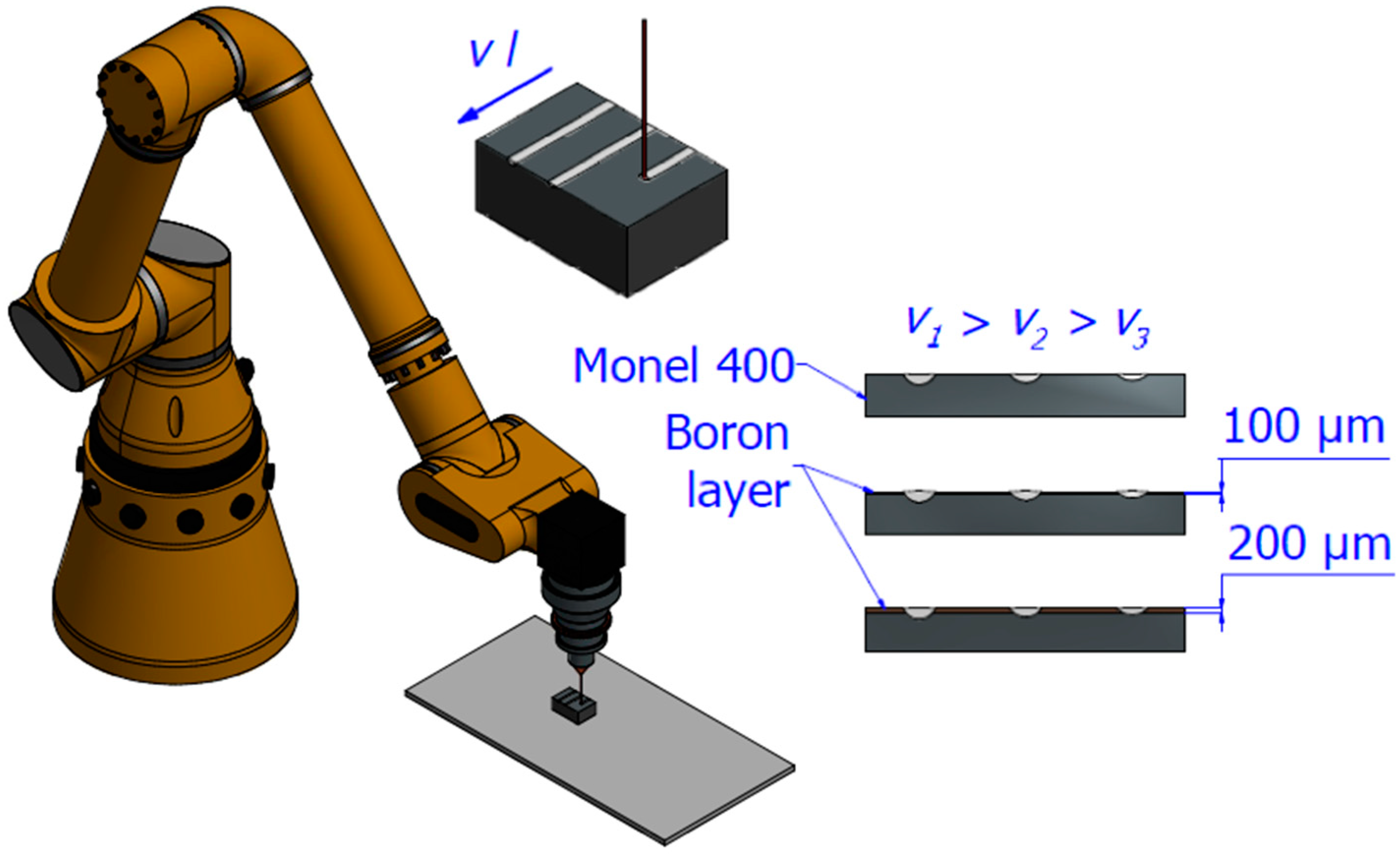
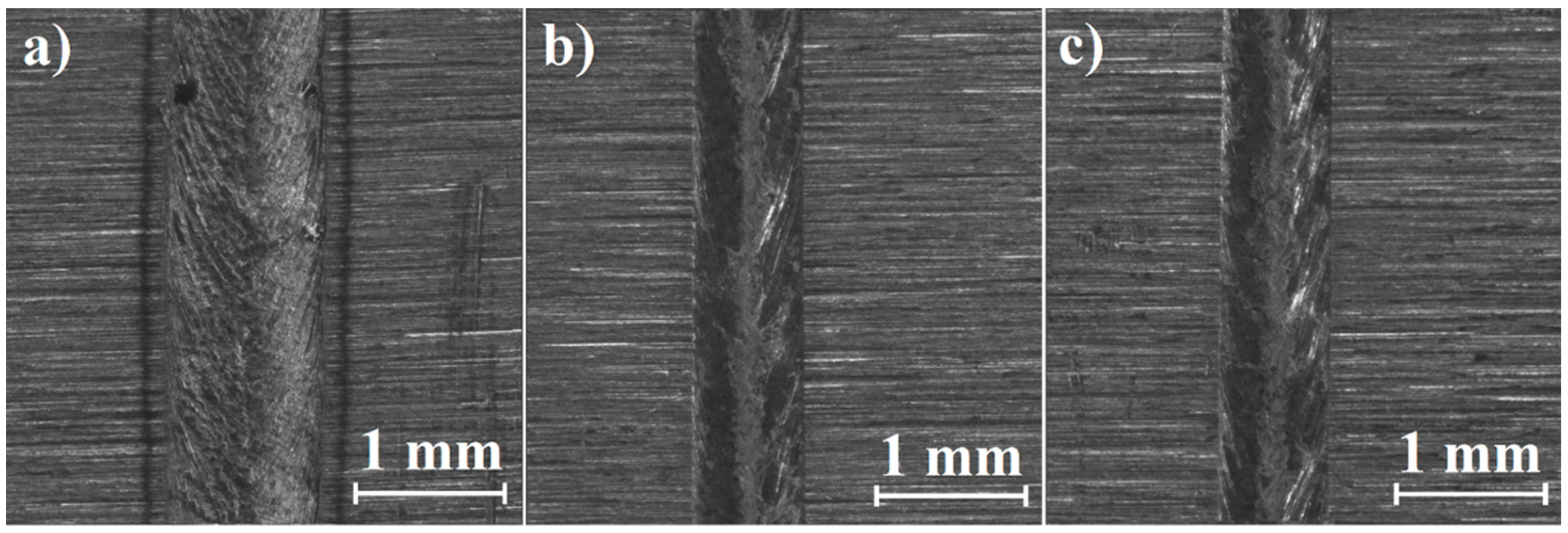
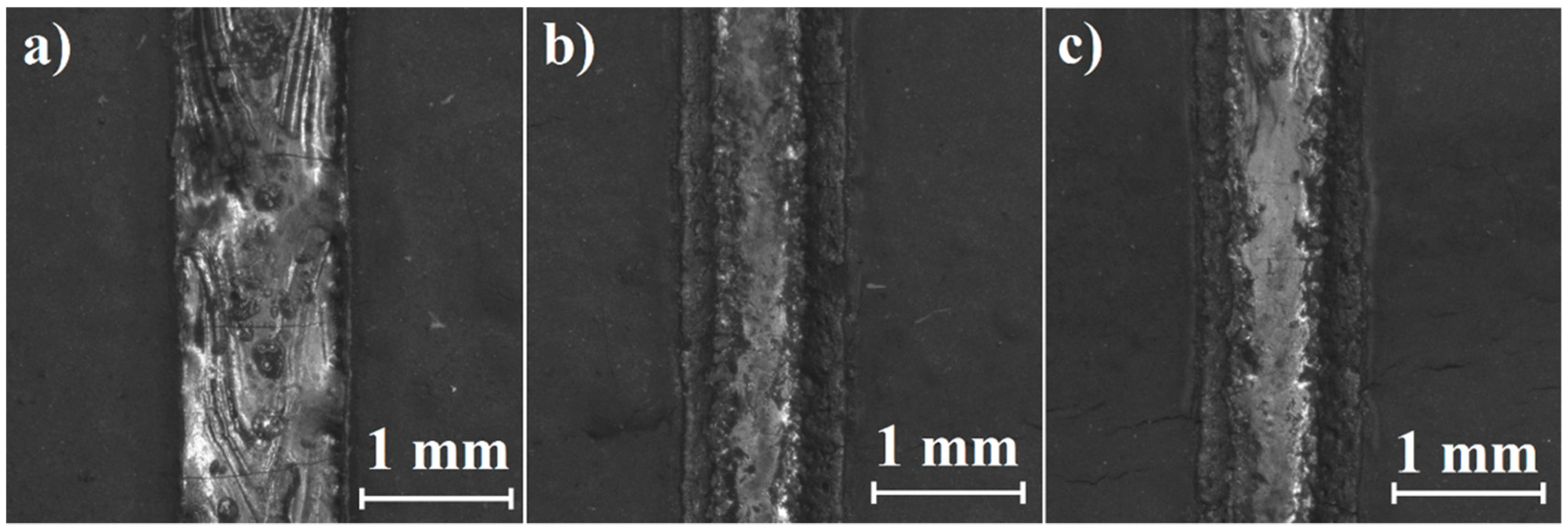
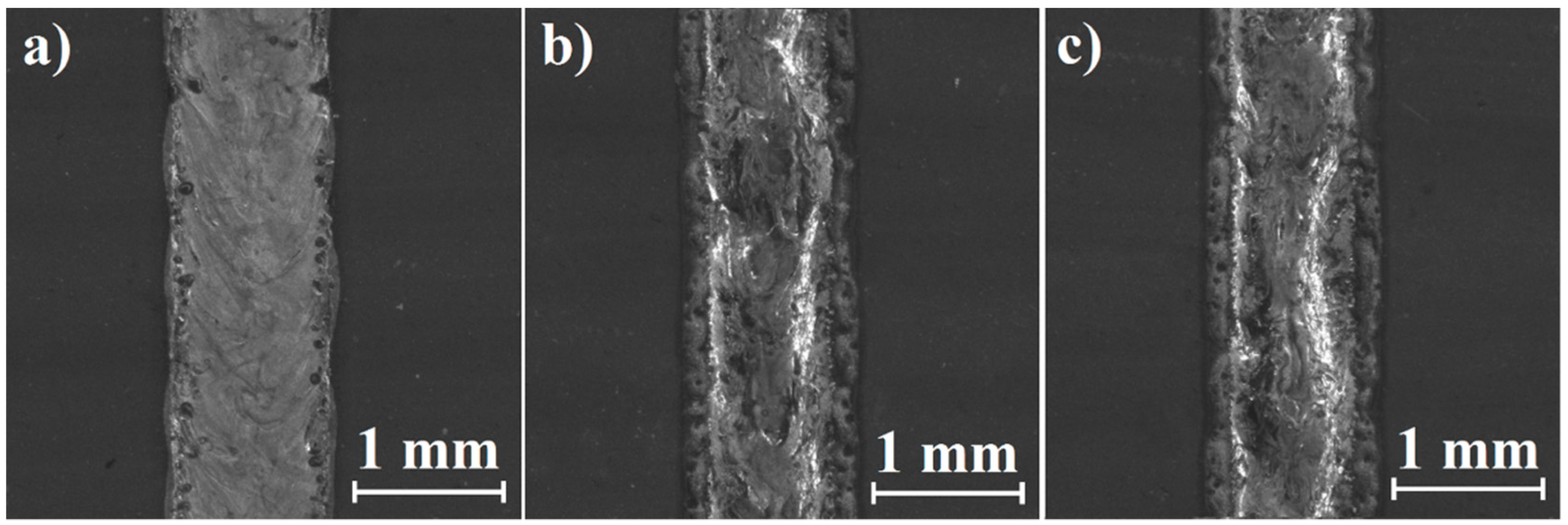
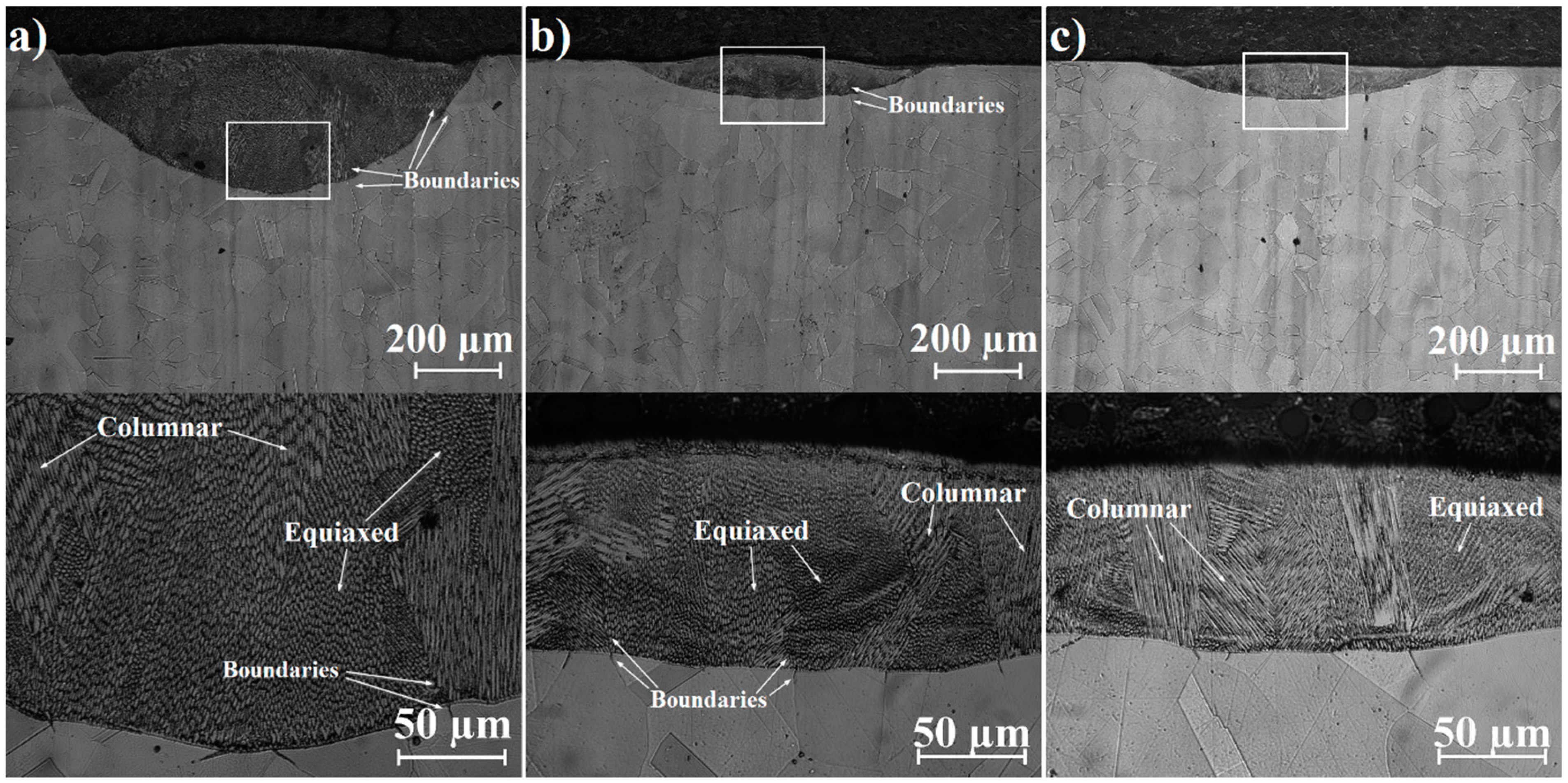

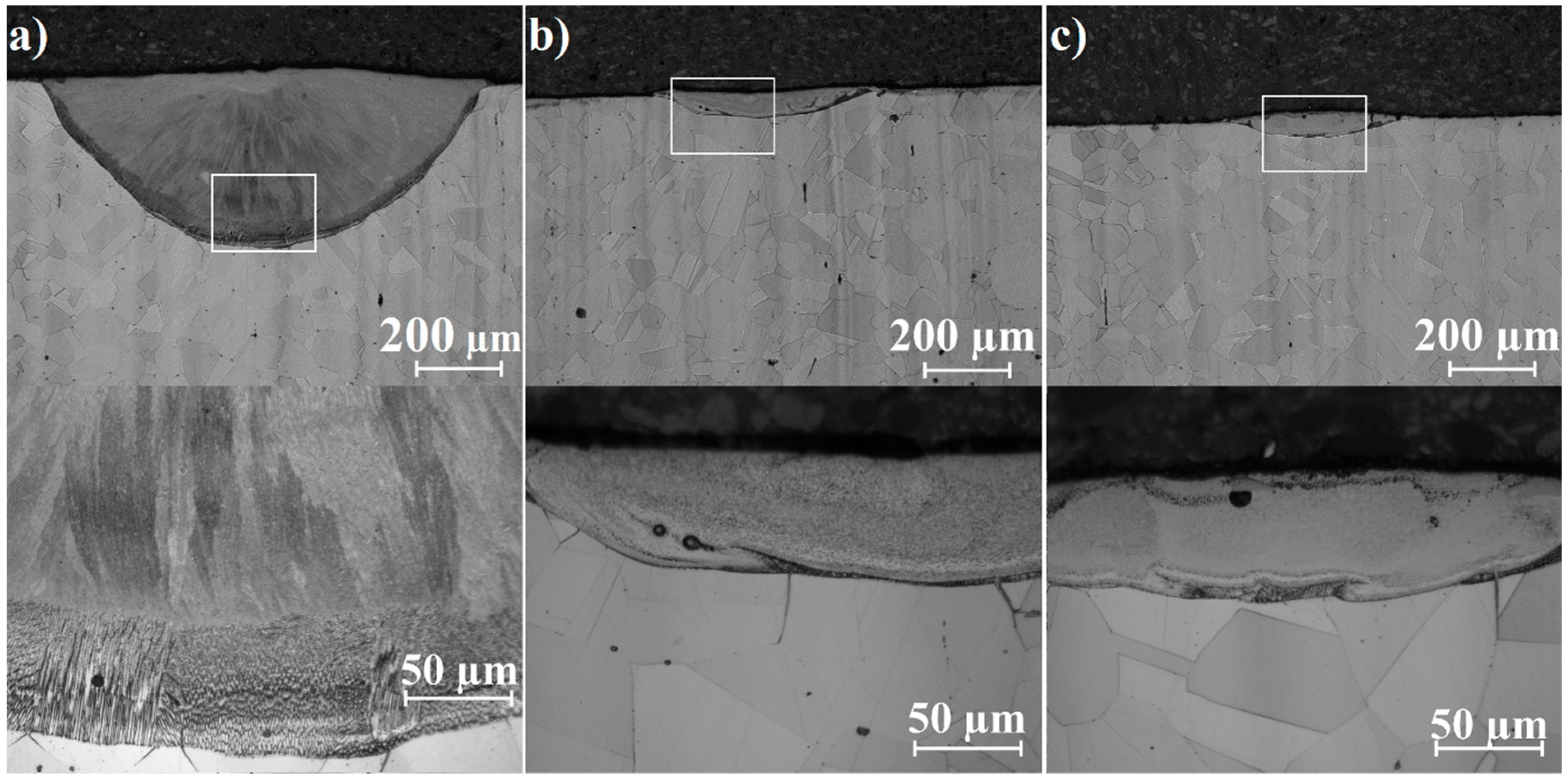
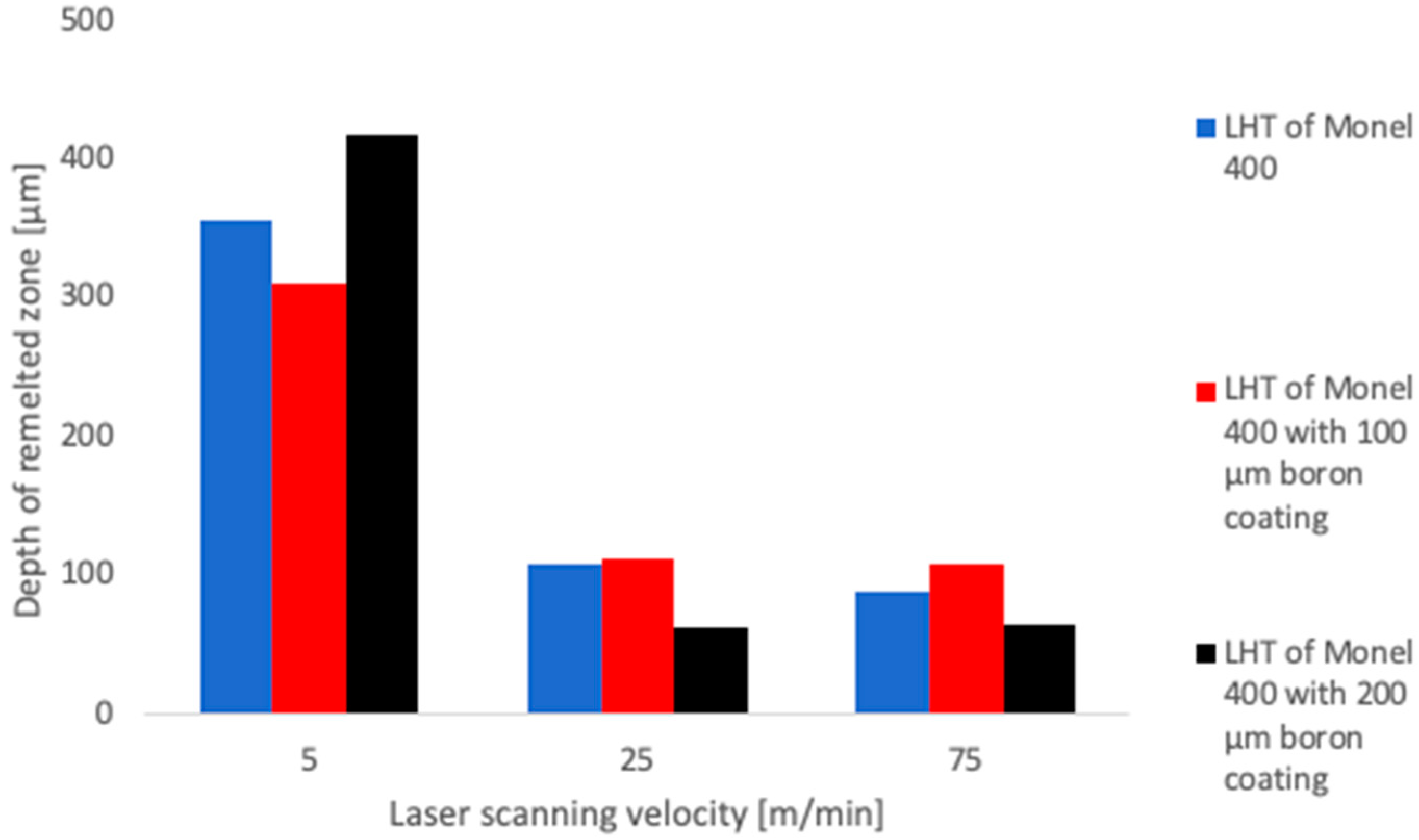


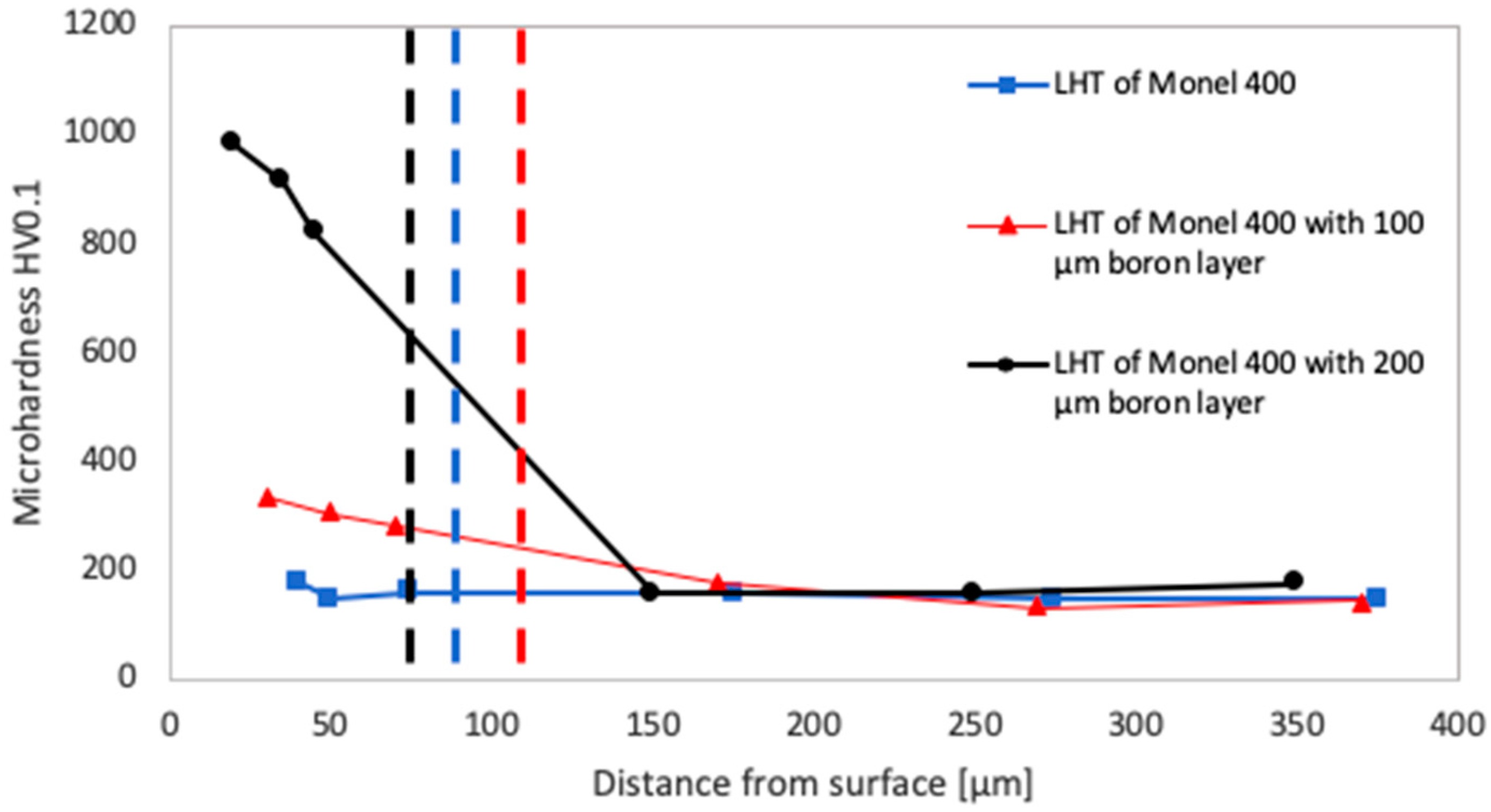
| Cu | Si | Fe | Mn | C | S | Ni |
|---|---|---|---|---|---|---|
| 31 | 0.5 | 2.5 | 2.0 | 0.3 | 0.024 | bal. |
| P [W] | q [kW/cm2] | vl [m/min] | dl [mm] | Et [s] | F [J/mm2] |
|---|---|---|---|---|---|
| 1400 | 178 | 5 | 1 | 0.012 | 21.4 |
| 25 | 0.0024 | 4.3 | |||
| 75 | 0.0008 | 1.4 |
© 2019 by the authors. Licensee MDPI, Basel, Switzerland. This article is an open access article distributed under the terms and conditions of the Creative Commons Attribution (CC BY) license (http://creativecommons.org/licenses/by/4.0/).
Share and Cite
Kuklinski, M.; Bartkowska, A.; Przestacki, D. Laser Alloying Monel 400 with Amorphous Boron to Obtain Hard Coatings. Materials 2019, 12, 3494. https://doi.org/10.3390/ma12213494
Kuklinski M, Bartkowska A, Przestacki D. Laser Alloying Monel 400 with Amorphous Boron to Obtain Hard Coatings. Materials. 2019; 12(21):3494. https://doi.org/10.3390/ma12213494
Chicago/Turabian StyleKuklinski, Mateusz, Aneta Bartkowska, and Damian Przestacki. 2019. "Laser Alloying Monel 400 with Amorphous Boron to Obtain Hard Coatings" Materials 12, no. 21: 3494. https://doi.org/10.3390/ma12213494
APA StyleKuklinski, M., Bartkowska, A., & Przestacki, D. (2019). Laser Alloying Monel 400 with Amorphous Boron to Obtain Hard Coatings. Materials, 12(21), 3494. https://doi.org/10.3390/ma12213494







